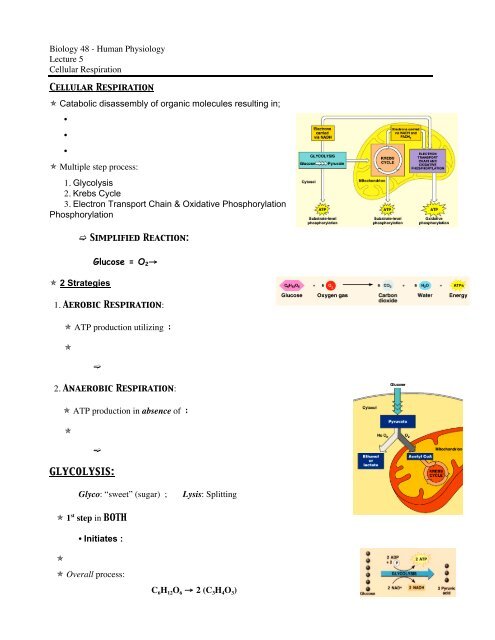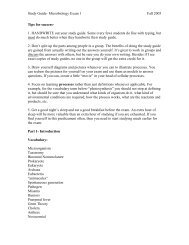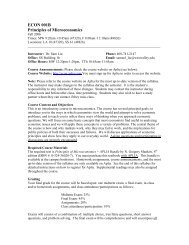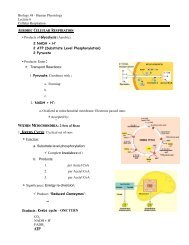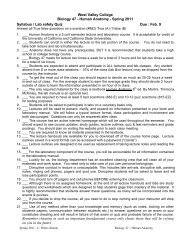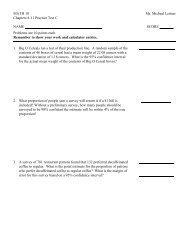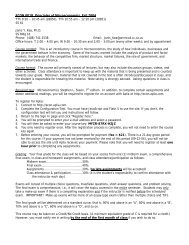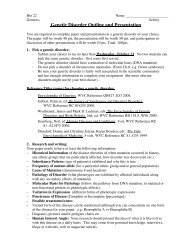Biology 48 - Human Physiology Lecture 5 Cellular Respiration ...
Biology 48 - Human Physiology Lecture 5 Cellular Respiration ...
Biology 48 - Human Physiology Lecture 5 Cellular Respiration ...
You also want an ePaper? Increase the reach of your titles
YUMPU automatically turns print PDFs into web optimized ePapers that Google loves.
<strong>Biology</strong> <strong>48</strong> - <strong>Human</strong> <strong>Physiology</strong><br />
<strong>Lecture</strong> 5<br />
<strong>Cellular</strong> <strong>Respiration</strong><br />
<strong>Cellular</strong> <strong>Respiration</strong><br />
Catabolic disassembly of organic molecules resulting in;<br />
•<br />
•<br />
•<br />
Multiple step process:<br />
1. Glycolysis<br />
2. Krebs Cycle<br />
3. Electron Transport Chain & Oxidative Phosphorylation<br />
Phosphorylation<br />
Simplified Reaction:<br />
2 Strategies<br />
Glucose = O2→<br />
1. Aerobic <strong>Respiration</strong>:<br />
ATP production utilizing :<br />
<br />
<br />
2. Anaerobic <strong>Respiration</strong>:<br />
ATP production in absence of :<br />
<br />
<br />
GLYCOLYSIS:<br />
Glyco: “sweet” (sugar) ; Lysis: Splitting<br />
1 st step in BOTH<br />
<br />
• Initiates :<br />
Overall process:<br />
C 6H 12O 6 → 2 (C 3H 4O 3)
Steps in Glycolysis:<br />
1. Glucose “Activation”<br />
<br />
Glucose → 2 (Pyruvate) or Pyruvic Acid<br />
Activated <strong>Cellular</strong> Glucose: “Locked” within cell by :<br />
Phosphate obtained from :<br />
Result:Fructose1,6 Diphosphate<br />
Glycolysis: Requires INITIAL energy investment of :<br />
of :<br />
2. Production of :<br />
C6H12O6+ 2ATP→ 2 (C3H4O3) + 4ATP<br />
For every glucose molecule:<br />
3. Production of :<br />
4 ATP produced<br />
- 2 ATP invested<br />
C 6H 12O 6 + 2ATP→ 2 (C 3H 4O 3) + 4ATP<br />
C 6H 12O 6 → 2 ( C 3H 4O 3 )<br />
4 missing hydrogen atoms ?<br />
C = 6 C (3x2) =<br />
H = 12 H (4x2) =<br />
O = 6 O (3x2) =<br />
Question: What happened to the electrons ? What molecules might be holding them ?
Answer:<br />
• Glycolysis: Results in:<br />
• NAD is<br />
Loss of<br />
Loss of<br />
Each picks up :<br />
or<br />
2NAD + + 2H 2→ 2NADH+ H +<br />
Products : 2 Pyruvic acid (Pyruvic Acid)<br />
2 NADH + H +<br />
4 ATP<br />
Question: What molecules must be present in order for glycolysis to continue?<br />
Answer:<br />
1. Glucose: “Stored Energy”<br />
Supplied from :<br />
2. 2 ATP: “Activation”<br />
Supplied from :<br />
Use 2 ATPs for:<br />
3. NAD + : “Electron carrier”<br />
NAD + NOT a product of :<br />
NADH + H + is :<br />
Oxidized back into :<br />
Ready to accept :<br />
NADH+ H + : Oxidation : 2 Strategies<br />
1. Aerobically: <strong>Cellular</strong> Oxygen Present<br />
• Oxidation occurs w/in :<br />
2. Anaerobically: <strong>Cellular</strong> Oxygen Limited<br />
• Oxidization occurs w/in :<br />
Anaerobic <strong>Respiration</strong>: “Fermentation”<br />
“Fermentation”
• NADH + H + :<br />
Donates Hydrogens to :<br />
Reduces Pyruvic Acid into :<br />
• Products: Anaerobic <strong>Respiration</strong><br />
2 ATP molecules (NET)<br />
2 Lactic Acid (reduced)molecules<br />
(reduced)molecules<br />
2 NAD + (Oxidized)<br />
NAD oxidized &<br />
Substrate Level Phosphorylation<br />
ATP production results from using bond energy in :<br />
• Negative Effects of Anaerobic <strong>Respiration</strong><br />
1.<br />
2.<br />
Decreases intracellular:<br />
Resting Skeletal Muscle pH = 7.0<br />
Exercising Muscle pH = 6.4<br />
• Interferes w/ Ca 2+ release & muscle contraction<br />
• Inhibits muscle :<br />
Muscle Weakness & Fatigue<br />
Muscle pain<br />
Lactic Acid Removal: Normal Daily occurrence<br />
occurrence<br />
• Lactic Acid inter-converted back into:<br />
Occurs within :<br />
Blood carries :<br />
• Liver produces: “Reverse Glycolysis Enzymes”<br />
Glycolysis Enzymes”<br />
• Glucose 6-Phosphate fates:<br />
Conversion into:<br />
a. Liver Glycogen :
. “Free” :<br />
Blood glucose: Available to :<br />
Only the liver can de-phosphorylate & release :<br />
• CORI CYCLE : 2-way traffic between :<br />
Blood Glucose:<br />
a. Utilized immediately:<br />
b. Stored:<br />
Study Questions :<br />
1. Define <strong>Cellular</strong> respiration. What is the overall highly simplified reaction for cellular respiration?<br />
What are the three primary sets of reactions involved?<br />
2. What are the two main strategies for energy utilization (hint one converts energy more efficiently<br />
than the other) Each strategy is advantageous under specific physiological circumstances; explain<br />
when you think each might be an advantage? One of the two process is definitely preferred under<br />
most conditions, explain why.<br />
3. What is the first step involved in cellular respiration of glucose by cells? Can cellular glucose be<br />
released from a cell once it is taken up? Why or why not? Does this initial step occur regardless of<br />
the presence of oxygen?<br />
4. From where is the phosphate needed for glucose activation derived?<br />
5. What does glycolysis literally mean? What are the products of this reaction?<br />
6. Diagram the overall reaction of Glycolysis (do not include all of the intermediate steps – just the<br />
components going into the reactions and the products coming out).<br />
7. 2 Pyruvic acids have 4 less hydrogens than the original glucose; where do these hydrogens end<br />
up?<br />
8. Why must NADH be oxidized into NAD+? In this oxidation reaction, what molecule is reduced?<br />
What is the reduced form of the molecule called?<br />
9. What are the two strategies for oxidizing NADH?<br />
10. Why is Lactic Acid produced in the absence of oxygen? Why do cells prefer NOT to utilize<br />
anaerobic respiration (Lactic Acid Fermentation)?<br />
11. How is the lactic acid removed from the muscle cells? Why can’t the skeletal muscle cells simply<br />
reconvert the lactic acid into glucose 6-phosphate themselves?<br />
12. Why is it important for cells to : 1) immediately phosphorylate glucose as it enters the cells &2)<br />
Why must glucose be stored as a macromolecule / polymer (glycogen)? What is the only organ<br />
which synthesizes the enzymes capable of catalyzing reverse glycolysis? Why is this important?<br />
13. Niacin (VitB3) and Riboflavin(vitB2) are essential vitamins partially because of their role as<br />
coenzymes (NAD and FAD). With this in mind, what do you think are some of the symptoms related<br />
to Vit. B2 & 3 deficiencies?


